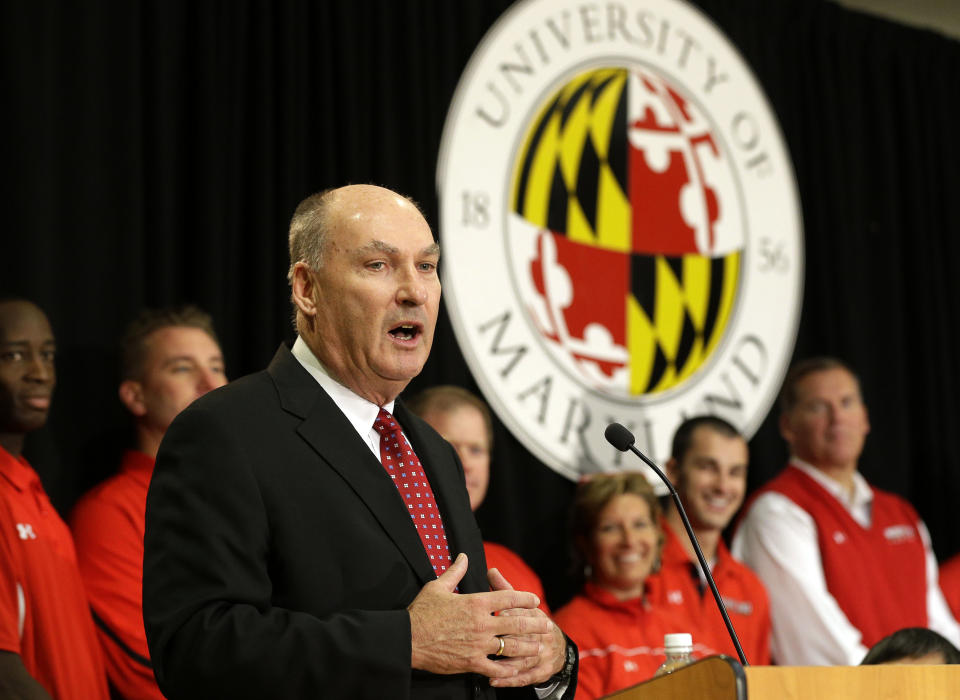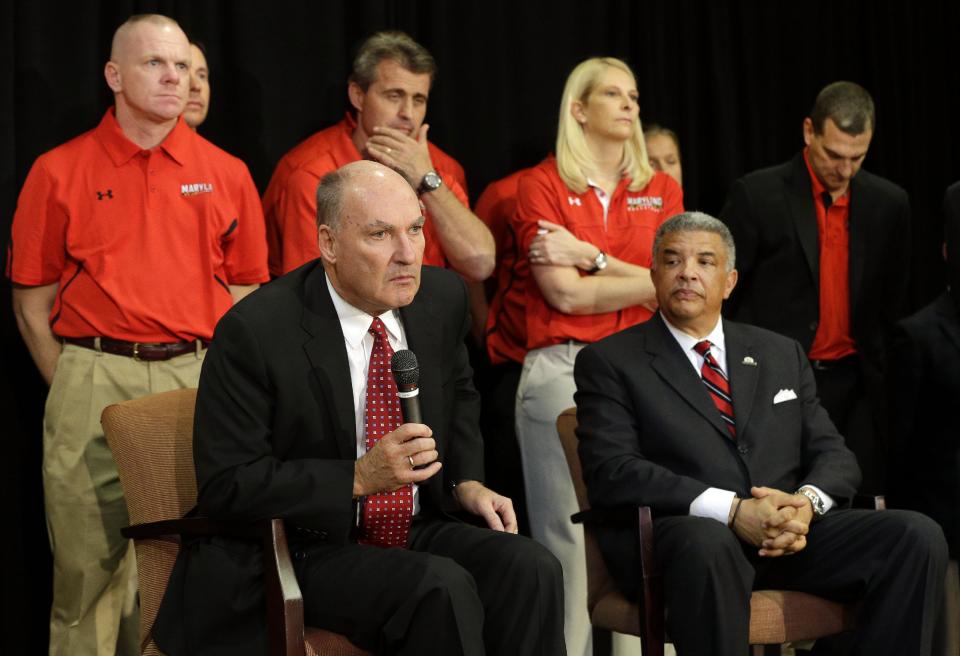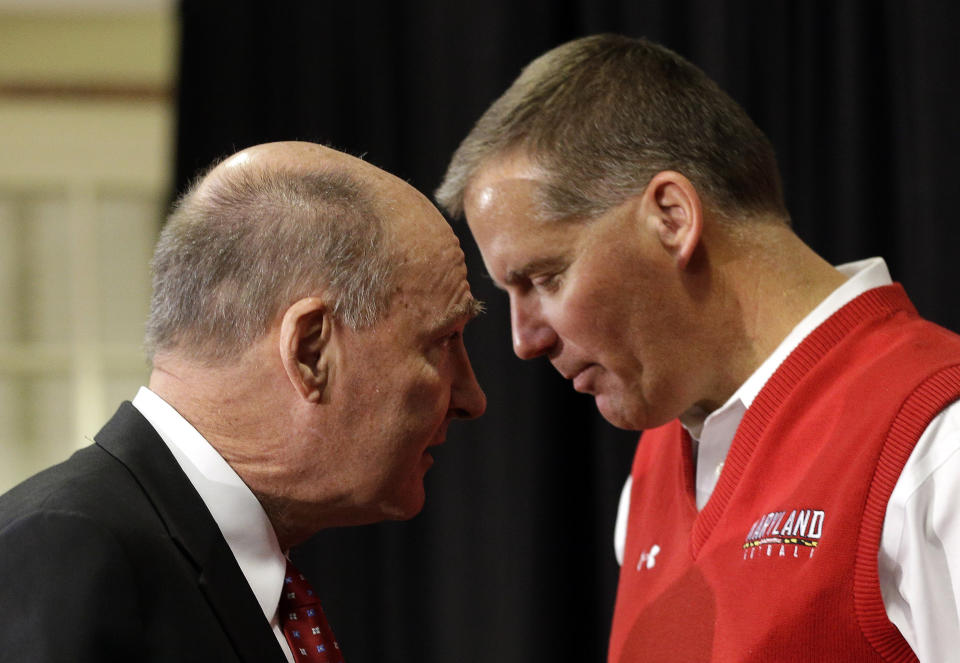No peace: Conference realignment revs up again
Just when it looked as if there would be peace, that the conferences were done realigning, the Big Ten struck another blow that will send shock waves across the country.
Financially strapped Maryland grabbed the Big Ten's lifeline on Monday, agreeing to become the conference's new southern base along the East Coast.
On Tuesday, Rutgers will gleefully jump aboard, too, and complete the Big Ten's new Mid-Atlantic bookends.
Big Ten Commissioner Jim Delany said the move was about demographics and claiming new territory, to keep the conference vibrant and competitive for decades to come.
Simply put: The Midwest is not growing fast enough to sustain the Big Ten long term, so it needs to go where the people are.
It was a move not for 2014, when the Terps and Scarlet Knights will settle into the Leaders Division with Ohio State and Wisconsin, but with an eye toward 2030.
"I think the best of both worlds is to have traditions, but also to be able to pivot toward creative innovations when the opportunity presents or is required," he said.
Delany noted how when the Southeastern Conference and Big 12 expanded, they planted their flags on new turf.
The Big 12 took West Virginia. The SEC added Texas A&M and Missouri, a school not far from what has always been considered Big Ten territory.
It should be noted that Maryland is about half as far from Atlanta as it is from Lincoln, Neb..
"We're very proud of the fact that the Big Ten has been Midwest-centric," Michigan athletic director David Brandon said. "But with population growth and shifts that have taken place over time, we know we need to grow into those areas where's there's more people, fans, alums and recruits."
So what's next for college football's most powerful and prominent conferences.
___
ACC
When the ACC added Notre Dame, without its football program, and increased its exit fee to $50 million, the conventional wisdom was that the league had been locked down.
But Maryland's departure is a reminder that the ACC is not on equal footing with the Big Ten — or the SEC, Pac-12 and Big 12 for that matter because football drives revenue and ACC football generally lags behind the other four.
SI.com reported that Maryland officials forecast the Big Ten will be paying each of its members $43 million in shared TV and media rights in 2017. The ACC projection for that season is $24 million per member.
There were rumblings of discontent coming from Florida State circles last summer, and rumors about Clemson and even Virginia Tech looking for better football competition.
Now those will no doubt start again.
"All of this conference jumping seems as if it keeps going and going," Florida State President Eric Barron said. "I don't necessarily understand it. The ACC is a fine conference, a fine conference academically and a fine conference athletically."
As for replacing Maryland, the ACC has already been getting phone calls from potential applicants, and should be familiar with the candidates since the league just went through the expansion process last year. That resulted in Pittsburgh and Syracuse leaving the Big East for the ACC. They arrive next year.
The ACC will look toward the Big East again. Connecticut and Louisville have both made it clear they'd like to upgrade. Maybe South Florida or Central Florida get into the mix.
This should not take long.
___
BIG EAST
Another conference that had to be thinking it was in the clear. The Big East just landed the access point it needed in college football's new postseason, rolled out its divisional alignment for its rebuilt 12-team football conference, which starts next year, and now it's scrambling again — while trying to negotiate a crucial TV deal.
New Commissioner Mike Aresco's job just got even tougher.
With Rutgers leaving, the Big East loses one of its best chips, a football member in the New York media market. Losing Connecticut would also chip into the Big East's foothold in the New York metropolitan area.
The Big Apple is becoming Big Ten and ACC country, and that's a big problem for the Big East.
The league countered its eastern losses by building a west wing with Boise State and San Diego State, and dipping into Texas with SMU and Houston. Are all those schools still on board with joining next year?
The Big East was already looking west for a 14th member to balance out the conference when Navy joins in 2015. BYU and Air Force are the top targets. Now it might need both, and one more because the pickings are slim in the east.
Then the football members have to figure out if it's worth sharing whatever revenue they do get from the new TV deal with St. John's, Georgetown and the five other non-football members.
___
BIG 12
Currently with 10 members, and apparently happy that way, the Big 12 in many ways holds the key to whether conference realignment turns into a frenzy again.
Chuck Neinas, who spent about 10 months as the Big 12's interim commissioner and helped hold the conference together when Texas A&M and Missouri left, said there is still no indication from the league's leaders that they want to go back to 12 members.
"Let's face it, they're making as much money as for the (Sugar Bowl) as the SEC and as the Pac-12 and Big Ten are making for the Rose Bowl and they only have to share it with 10 teams," he said in a phone interview Monday.
The new deal the Big 12 and SEC just signed with ESPN for the rights to the Sugar Bowl will pay the conferences about $40 million apiece per year.
Plus, the Big 12's new television deal included a grant of rights that makes it all but impossible for its current members to leave for the next dozen years.
"My feeling is there is stability there. I'd be very surprised if they looked at expansion," Neinas said.
___
PAC-12
Commissioner Larry Scott tried to go really big a couple years ago, when he targeted Texas and half the Big 12.
The Pac-12 settled for Utah and Colorado, then passed at a shot to possibly grab Oklahoma and Oklahoma State without Texas, because the conference leaders weren't ready to share their newfound riches.
With the Big 12 teams off the table, the Pac-12 simply doesn't have a lot of schools to choose from even if it did want to expand.
"They're in a difficult spot geographically," Neinas said.
__
SEC
The SEC has shown no desire to add members in states where it already has members.
That precludes the SEC from adding the most desirable and logical programs, such as Florida State and Clemson. That also knocks Louisville and Georgia Tech off the list.
Until the SEC ends that "gentlemen's agreement," as Neinas called it, it's potential for growth is limited. Not that it really needs to grow as it works on starting its own network, a la the Big Ten.
___
ESPN is owned by The Walt Disney Co.
___
AP sports writers Larry Lage in Detroit and Brent Kallestad in Tallahassee, Fla., contributed.
___
Follow Ralph D. Russo at www.Twitter.com/ralphDrussoAP




